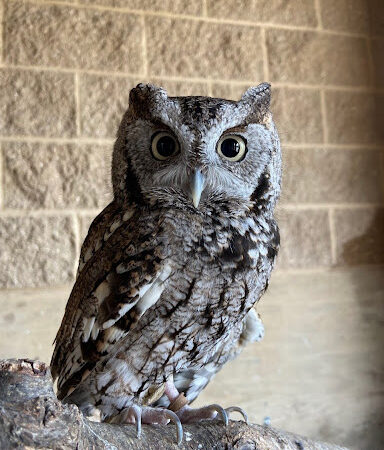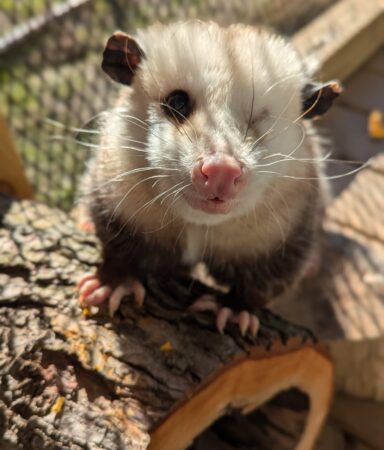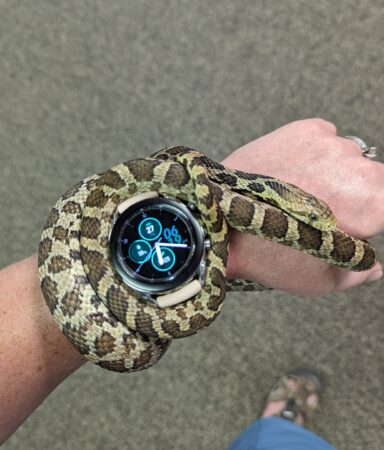Animal Ambassadors

Watson
Eastern screech owl
Scientific name: Megascops asio
~Estimated birthday: before 2017
Sex: Female?
Weight: ~130 grams
Watson came to live with Warren County Conservation on January 18th, 2017.
Watson was struck by a vehicle, resulting in a broken left wing. Unfortunately, the wing did not heal properly, leaving her unable to fly or hunt for food, which makes her non-releasable.
Species Information
Food:
These owls may be small, but they have a big appetite! They eat many small animals, including rats, mice, squirrels, moles, finches, earthworms, crayfish, and tadpoles, to name a few.
Behavior:
Screech owls are typically active at night, though it is not uncommon for them to be active at dawn and dusk. They are a sit-and-wait predator; they will find a nice comfy perch and wait for prey to walk by.
If you want more information about Eastern Screech Owls please visit https://www.allaboutbirds.org/guide/Eastern_Screech-Owl/overview

Marsi
Virginia opossum
Scientific name: Didelphis virginiana
~Estimated birthdate: spring of 2022
Sex: Female
Weight:
Marsi came to live with Warren County Conservation on June 10th, 2023.
She was found by a good Samaritan after being hit by a car and was taken to a licensed rehabilitator and wildlife veterinarian. She underwent surgery and ended up losing her tail and an eye to the injuries. After her babies (all 13 lived) were successfully raised and released Marsi came to live with us as she was non-releasable due to her missing eye and tail.
Species Information
Food:
Opossums are opportunistic and will eat pretty much anything they can find. This includes small mammals, birds, insects, worms, plants, fruits and seeds, eggs, and any trash left in an easily accessible trash can. Dog and cat food are also favorites and so easily accessible!
Behavior:
Virginia opossums are nocturnal and solitary. They are most active between dusk and dawn. While they do not hibernate, they do drastically reduce their activity during the coldest weather. Opossums do not do well in the cold and often adult opossums are missing tips of ears, tails, and toes due to frostbite.

Boo
Western foxsnake
Scientific name: Pantherophis ramspotti
~Estimated birthdate: summer of 2019
Sex: Female
Weight:
Boo came to live with Warren County Conservation in the late fall of 2019.
Boo was found after a freeze and was determined to be unable to get to a hibernacula in time to survive the winter. She was named after the pattern on the top of her head that looks like a ghost skull.
Species Information
Food:
The majority of fox snake diets are rodents, although they may eat frogs, birds, or eggs. Fox snakes are constrictors, which means they catch and squeeze their prey until the prey suffocates, then the snake can swallow the dead prey whole. They are NOT venomous and are extremely beneficial to the environment.
Behavior:
Fox snakes are most active during the day, especially in the spring and fall when the temperatures are slightly lower. During the hottest months, fox snakes prefer moving around at night. Fox snakes are PROTECTED by law in Iowa. Fox snakes (as well as some other harmless snakes) will shake their tail amongst the leaves and sticks producing a rattling or buzzing sound which often gets them misidentified as rattlesnakes. However, they do not have a rattle on their tail.

